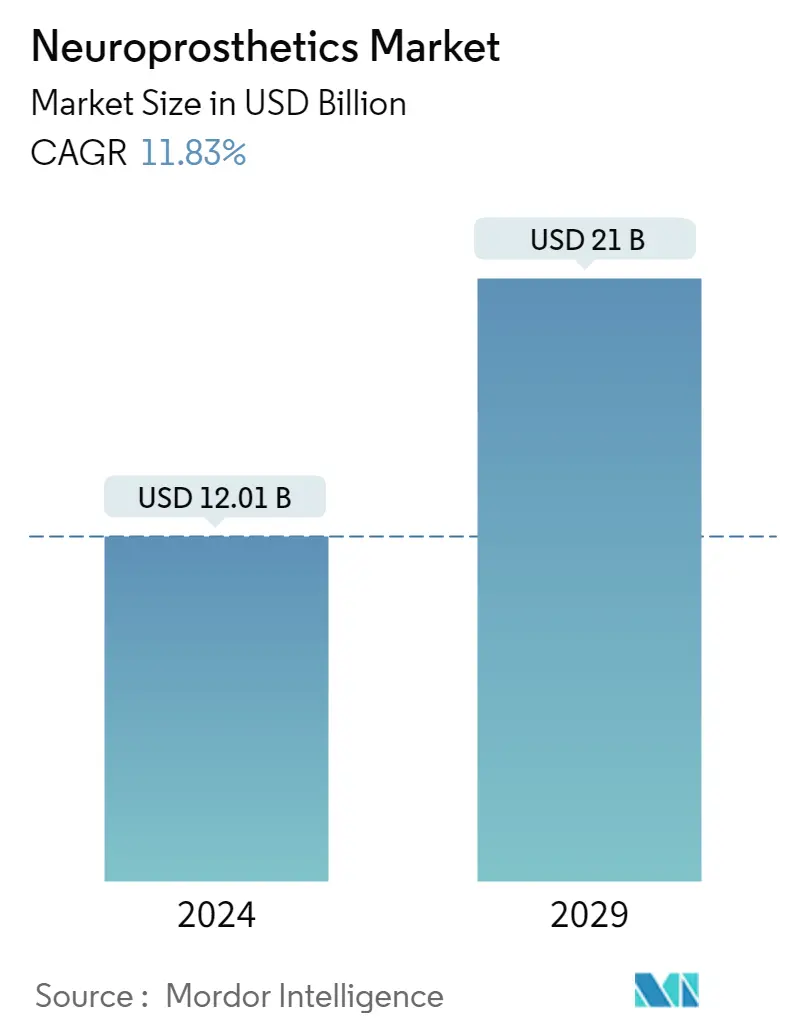Market Size of Neuroprosthetics Industry

| Study Period | 2019 - 2029 |
| Market Size (2024) | USD 12.01 Billion |
| Market Size (2029) | USD 21.00 Billion |
| CAGR (2024 - 2029) | 11.83 % |
| Fastest Growing Market | Asia Pacific |
| Largest Market | North America |
Major Players
*Disclaimer: Major Players sorted in no particular order |
Neuroprosthetics Market Analysis
The Neuroprosthetics Market size is estimated at USD 12.01 billion in 2024, and is expected to reach USD 21 billion by 2029, growing at a CAGR of 11.83% during the forecast period (2024-2029).
The neuroprosthetics market was significantly impacted by the outbreak of the COVID-19 pandemic initially. According to an article published by PubMed Central in January 2021, hearing loss was said to be a relatively newly reported symptom of COVID-19, and the study further showed that two cochlear-implanted children showed symptoms of a sudden speech perception problem after being infected with COVID-19. Thus, owing to the aforementioned factors, the pandemic had a considerable impact on the studied market initially. However, currently, as the pandemic has subsided that market has gained traction and it is expected to have stable growth during the forecast period of the study.
Factors such as the increasing number of patients suffering from neurological disorders and nerve injury and the growing burden of hearing loss and related defects are expected to enhance the growth of the market.
People with hearing loss benefit from early identification as it enables the use of hearing aids, cochlear implants, and other devices. According to the World Health Organization, in 2021, approximately 2.5 billion population globally are estimated to experience hearing loss by 2050, and nearly 700 million are estimated to require hearing rehabilitation by 2050. Thus, the high burden of hearing loss among the global population is one of the major drivers for the growth of the neuroprosthetics market. The cochlear implant is one of the key neuroprosthetic devices that had provided immense benefits for people with deafness or severely hard-of-hearing. This device can also be used by patients who have experienced intense hearing loss caused by disease or injury, allowing them to hear sounds in their environment. Hence, with the increasing incidences of hearing loss, scientists are investing more in novel neuroprosthetics, which will drive the market over the forecast period.
According to the data by WHO in February 2022, epilepsy is a chronic noncommunicable neurological disease of the brain that affects people of all ages, and around 50 million people worldwide have epilepsy, making it one of the most common neurological diseases globally. It is estimated that nearly 80% of people with epilepsy live in low- and middle-income countries. The increasing prevalence of neurological diseases like epilepsy is also expected to enhance the market growth.
Furthermore, key developments in the market is also a major factor driving the growth of the market. For instance, in April 2021, Houston Methodist and Rice U. collaborated to develop translational neural prosthetics and interfaces to focus on restoring brain function after disease or injury. Thus, in view of the developments regarding neuroprosthetics, the neuroprosthetics market is expected to register healthy growth in the coming years.
Therefore, owing to the aforementioned factors such as the increasing number of patients suffering from neurological disorders and nerve injury, the growing burden of hearing loss and related defects, and the key developments in the market, the studied market is anticipated to witness growth over the analysis period. However, the availability of alternative treatment options and the high cost of neuroprosthetics are likely to impede the market's growth.
Neuroprosthetics Industry Segmentation
As per the scope of the report, neuroprosthetics is a branch of neuroscience and biomedical engineering concerned with developing neural prostheses. Neural prostheses are an array of devices that can substitute the functions of a motor, sensory, or cognitive modality that may have been damaged, as a result of an injury or a disease. The Neuroprosthetics Market is segmented by Type (Output Neural Prosthetics and Input Neural Prosthetics), Technique (Spinal Cord Stimulation, Deep Brain Stimulation, Vagus Nerve Stimulation, and Other Techniques), Application (Parkinson's Disease, Alzheimer's Disease, Epilepsy, Auditory Processing Disorders, Ophthalmic Disorders, and Other Applications), and Geography (North America, Europe, Asia-Pacific, Middle East and Africa, and South America). The market report also covers the estimated market sizes and trends for 17 different countries across major regions, globally. The report offers the value (in USD million) for the above segments.
| By Type | |
| Output Neural Prosthetics | |
| Input Neural Prosthetics |
| By Technique | |
| Spinal Cord Stimulation | |
| Deep Brain Stimulation | |
| Vagus Nerve Stimulation | |
| Other Techniques |
| By Application | |
| Parkinson's Disease | |
| Alzheimer's Disease | |
| Epilepsy | |
| Auditory Processing Disorders | |
| Ophthalmic Disorders | |
| Other Applications |
| Geography | ||||||||
| ||||||||
| ||||||||
| ||||||||
| ||||||||
|
Neuroprosthetics Market Size Summary
The neuroprosthetics market is poised for significant growth, driven by an increasing prevalence of neurological disorders and a rising burden of hearing loss globally. The market, which experienced initial setbacks due to the COVID-19 pandemic, has since regained momentum and is expected to expand steadily over the forecast period. Key factors contributing to this growth include the growing number of patients with neurological conditions such as epilepsy and the high incidence of hearing loss, which necessitates the use of devices like cochlear implants. These advancements in neuroprosthetic technology are further supported by ongoing research and development efforts, as well as collaborations aimed at restoring brain function after disease or injury. The input neural prosthetics segment, which includes cochlear implants and bionic eyes, is anticipated to witness robust growth due to technological advancements and the increasing demand for hearing rehabilitation.
Regionally, North America is expected to hold a significant share of the neuroprosthetics market, bolstered by a high prevalence of neurological disorders and hearing loss among the aging population. The region's market growth is further supported by a concentration of global players, research activities, and a trend towards product approvals. The market's competitive landscape features major players such as Abbott Laboratories, Boston Scientific Corporation, and Medtronic PLC, among others. Despite the promising growth prospects, challenges such as the high cost of neuroprosthetics and the availability of alternative treatment options may impede market expansion. Nonetheless, the increasing awareness and research in neuroprosthetics, coupled with the rising incidence of neurological disorders and hearing loss, are expected to drive market growth in the coming years.
Neuroprosthetics Market Size - Table of Contents
-
1. MARKET DYNAMICS
-
1.1 Market Overview
-
1.2 Market Drivers
-
1.2.1 Increasing Number of Patients Suffering from Neurological Disorders and Nerve Injury
-
1.2.2 Growing Burden of Hearing Loss and Related Defects
-
-
1.3 Market Restraints
-
1.3.1 Availability of Alternative Treatment Options
-
1.3.2 High Cost of Neuroprosthetics
-
-
1.4 Porter's Five Forces Analysis
-
1.4.1 Threat of New Entrants
-
1.4.2 Bargaining Power of Buyers/Consumers
-
1.4.3 Bargaining Power of Suppliers
-
1.4.4 Threat of Substitute Products
-
1.4.5 Intensity of Competitive Rivalry
-
-
-
2. MARKET SEGMENTATION (Market Size by Value - USD million)
-
2.1 By Type
-
2.1.1 Output Neural Prosthetics
-
2.1.2 Input Neural Prosthetics
-
-
2.2 By Technique
-
2.2.1 Spinal Cord Stimulation
-
2.2.2 Deep Brain Stimulation
-
2.2.3 Vagus Nerve Stimulation
-
2.2.4 Other Techniques
-
-
2.3 By Application
-
2.3.1 Parkinson's Disease
-
2.3.2 Alzheimer's Disease
-
2.3.3 Epilepsy
-
2.3.4 Auditory Processing Disorders
-
2.3.5 Ophthalmic Disorders
-
2.3.6 Other Applications
-
-
2.4 Geography
-
2.4.1 North America
-
2.4.1.1 United States
-
2.4.1.2 Canada
-
2.4.1.3 Mexico
-
-
2.4.2 Europe
-
2.4.2.1 Germany
-
2.4.2.2 United Kingdom
-
2.4.2.3 France
-
2.4.2.4 Italy
-
2.4.2.5 Spain
-
2.4.2.6 Rest of Europe
-
-
2.4.3 Asia-Pacific
-
2.4.3.1 China
-
2.4.3.2 Japan
-
2.4.3.3 India
-
2.4.3.4 Australia
-
2.4.3.5 South Korea
-
2.4.3.6 Rest of Asia-Pacific
-
-
2.4.4 Middle East and Africa
-
2.4.4.1 GCC
-
2.4.4.2 South Africa
-
2.4.4.3 Rest of Middle East and Africa
-
-
2.4.5 South America
-
2.4.5.1 Brazil
-
2.4.5.2 Argentina
-
2.4.5.3 Rest of South America
-
-
-
Neuroprosthetics Market Size FAQs
How big is the Neuroprosthetics Market?
The Neuroprosthetics Market size is expected to reach USD 12.01 billion in 2024 and grow at a CAGR of 11.83% to reach USD 21.00 billion by 2029.
What is the current Neuroprosthetics Market size?
In 2024, the Neuroprosthetics Market size is expected to reach USD 12.01 billion.

